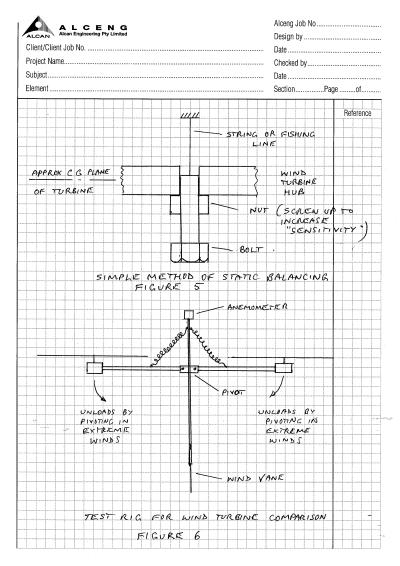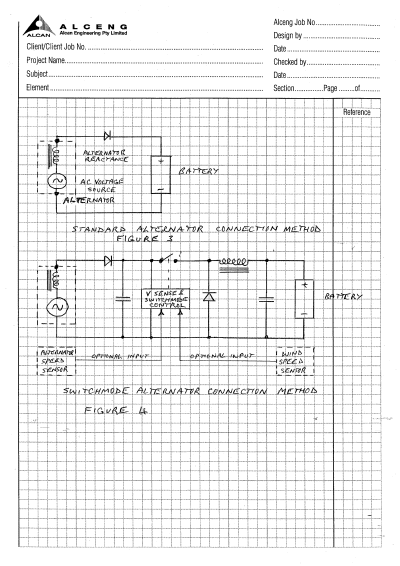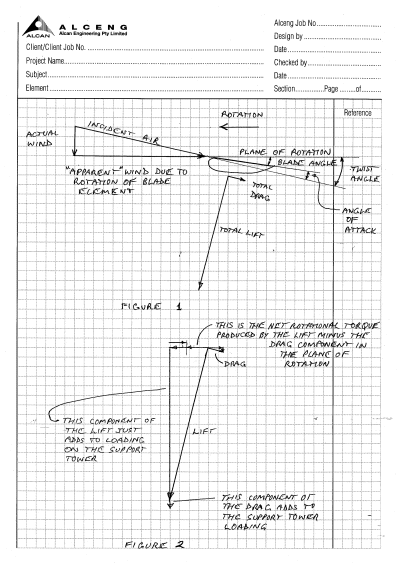 |
|
|
Site Navigation
Projects & Information
»General Information»Wind turbine Projects »The F&P Smartdrive »Electronic projects »Microcontroller projects »Miscellaneous Kits & Parts
»Basicly Natural Pty Ltd»PVC & Aluminium blades »Scale model farm windmills »Price Watch Discussion Forums
Handy Links
»Wind»Solar »Electric Vehicles »Electronics »Micro Controllers »General Interrest About TheBackShed Getting Started Privacy Policy |
By Don Brown The following article was sent to Silicon Chip Magazine as a response to my first windmill article. Don sent me a copy and I thought it was so good I asked him if I could place it on my web site.
My congratulations to Glenn Littleford for Part 1 of his December 2004 article in Silicon Chip magazine on Windmill Generators. Like Glenn, they are a topic dear to my own heart, and I have been tinkering with them as a hobby over the last 15 years or so.
Power in the wind and power extraction - As a rough rule of thumb, you would require an 8 metre
diameter turbine to extract 1 kilowatt of power from
a 5 metre per second wind (18 kph). This assumes that
the turbine is 30% efficient. According to a Mr. Betz,
you can actually only extract 60% of the wind energy
anyway. Blade Twist or Helix- There is
a lot of science in efficient blade design, and I don't
pretend great expertise. The principle of blade twist
is, however, relatively simple. Air arriving at the
leading edge of a turbine blade hits the blade with
the speed of the wind in an axial direction, while the
blade simultaneously hits the air at its circumferential
speed. The circumferential speed depends on the radius
of the point in question from the turbine axis, and
is obviously fastest at the tip. Aerofoils - At high wind speeds
there is so much wind power available that even bits
of packing case timber set at an angle to the wind can
generate power. The art is in efficiently extracting
power at low wind speeds. Efficient turbines use aerofoil
sections, like those used for the wings and propellors
of aeroplanes. Attainment of high orders of L/D ratio are
very much dependent on accurate reproduction of the aerofoil
design, and a very high standard of finish. There are dozens
(hundreds, probably) of aerofoil sections that have been developed
by bodies such as NACA (now NASA), and their development is
a science in itself. Angle of Attack. The angle between
the incident air and the aerofoil chord (line between the
leading and trailing edges) is called the Angle of Attack.
As a rule of thumb, the highest lift is developed at an angle
of attack of about 10 to 12 degrees to the incident air. The
point of stall, where the air flow detatches from the lifting
side and the lift collapses, occurs at an angle of about 16
degrees. The AA that provides the highest Lift to Drag ratio
is the angle of most interest to aeroplane designers, and
occurs somewhere between 0 to 4 degrees, depending upon the
aerofoil selected. |
||
|
Turbine Blade Angle - For best efficiency,
a turbine blade needs to be set at the twist angle minus the
desired angle of attack (i.e. the blade angle - see Figure
1). Suggested blade angles for a percentage of blade radii
for a typical three-blade turbine with a TSR of 4.5 are given
in the Table 2. This is based on an arbitrarily selected AA
of 4 degrees, but this can be the subject of some experimentation
(in association with different aerofoils). The AA does not
need to be constant for all of the blade length (nor does
the aerofoil section), and this is a fertile area for the
experimenter to research. Blade taper and thickness - There are
both aerodynamic and mechanical reasons for tapering the blade
(ie reducing the width) towards the tip. Both relate to square
law effects. As the width (chord) decreases, the thickness
needs to reduce at least in proportion. Overspeed and blade forces - Because
of the huge increase in wind power as the speed increases,
wind turbines can spin to destruction even if loaded to the
maximum extent capable from the alternator. As noted above,
the force trying to rip the blades out of the hub increases
with the square of the rotational speed. To put some dimension
to this, a 2 metre diameter blade weighing 4kg and rotating
at 1,200 RPM develops a centrifugal force of about 3 tonnes.
Even if only part of a blade breaks off, the resulting out
of balance rotation of what remains will quickly destroy the
generator and support structure, Balance - Because of the substantial
centrifugal forces that can develop, the turbine must be well
balanced. The simplest way to do this is to take a nut and
bolt of the same diameter as the turbine shaft, and to drill
a small hole through the exact centre of the bolt. A piece
of string or fishing line is then fed through the hole, and
the turbine is suspended with the blade horizontal. Blade attachments - Don't forget that
the most highly stressed part of a turbine blade will be the
root and its attachment point to the hub. This presents some
challenges for a 3 bladed prop. Be particularly careful to
avoid abrupt section changes or other stress raisers such
as holes in this area. Remember also that the centrifugal
forces produced by one blade are balanced by the other two,
and the hub design must provide adequate material section
for the transfer of these forces. Fatigue - Because of pressure changes
due to wind masking by, say, the support tower, each rotation
of the turbine produces stress changes which can lead to ultimate
fatigue failure in some materials - notably aluminium. The
wind turbine has been described as a very good fatigue generator,
in addition to anything useful that it might do, so keep up
the inspections. Rotational Hazard - Just like aeroplane
propellors, rotating wind turbines are dangerous, and must
be treated with caution. This is especially so in an over-speed
condition, where anything breaking off becomes a dangerous
missile. The apparently slow rotating turbines in a wind farm
kill birds, who apparently do not realise that the tips are
travelling at 5 or 6 times wind speed. Starting - When the turbine is stationary,
the blades are in a deeply stalled condition, and require
a significantly higher wind speed that the minimum generating
wind speed to start rotating. This results in lost power generating
opportunities, and some generator controllers include a "bump"
facility to kick start rotation. Even a push helps. Vibration and Noise - Turbines driving
a single phase alternator are inherently noisy. The situation
is much improved with a multi-phase alternator. Conventional charging circuitry - A
typical wind turbine alternator connects to a (bridge) rectifier,
which then connects to the battery under charge (Figure 3).
Note that current can only flow from the alternator to the
turbine once its terminal voltage exceeds that of the battery
voltage, plus the diode bridge forward voltage drop. The current
waveform is therefore unlikely to be a clean sinusoid, and
some harmonics will be generated. Conventional charging circuit shortcomings - As noted above, for the turbine to operate at maximum
efficiency, it must run at or near its design TSR. This requires
that its turbine speed must linearly follow the wind speed.
For alternators with fixed excitation, the no-load voltage
will be proportional to shaft speed. Switchmode charging circuit - In Figure
4, the alternator is connected via a switchmode charging circuit,
which can let the alternator operate at voltages significantly
above the battery voltage. The switchmode circuit works by
connecting the alternator DC output voltage to the battery
for a brief period. The current that flows is limited by the
inductor, which also stores energy in the form of a magnetic
field. When the switch opens, the polarity of the voltage
of the inductance reverses, and current flow is maintained
through the battery and the Shottky diode while the magnetic
field dissipates. Open Loop Control - The switchmode
controller can be programmed to continually make an incremental
change to the alternator side voltage reference (ie shorten
the burst time to increase the alternator voltage level),
pause, and see if the current delivered to the battery increases.
If it does, then it makes a further incremental change, pauses,
and again checks the current. Should the battery current reduce,
it will decrement the voltage reference. Closed Loop Control - If the alternator
speed and the undisturbed wind speed are known, then the controller
can be set to maintain a constant ratio between the two. If
the wind should increase, the controller would shift to a
higher reference voltage consistent with the expected higher
turbine speed, thus unloading the turbine and assisting it
to accelerate to its expected speed. Wind Speed Sensing - Although it has
since sucumbed to the effects of UV and birds, I made a very
serviceable cup type anemometer out of three Andronicus coffee
measuring spoons. These drove an optical encoder built into
the case of a small DC motor shell with the magnetics and
brushes removed. I first tried a magnetic sensor, but found
that even the small cogging from the magnet interferred with
the operation. Alternator speed sensing - The simplest
way to do this is to set up a pulse counter to monitor the
alternator output frequency. How much better? - As the wind is always
changing, it is difficult to measure the extent of any improvements
that you think that you have made unless you have access to
a wind tunnel. The solution is to have two units identical
in every respect except for the feature that you are testing.
By mounting them on a common pivoting support and exposing
them to an airflow that is as undisturbed as possible, they
should see more or less the same air-flow. Alternator suitability - This is the point where I am looking forward to Glenn's
next article. I hope that the above observations provide
a little additional interest for your readers in conjunction
with Glenn's articles, and may, perhaps, elicit some comments
from others. Wind turbines (OK, I confess to calling them
windmills too - even though they don't produce flour) are
great things to experiment with - especially when you have
an understanding of the basics. There is always a fascination
with getting something for nothing from the wind or the sun. Incidentally, I have been reading and enjoying your magazine and its forebears since the days of "Radio and Hobbies" magazine, which probably gives my age away somewhat. Keep up the good work. Regards Don Brown
|
|||




